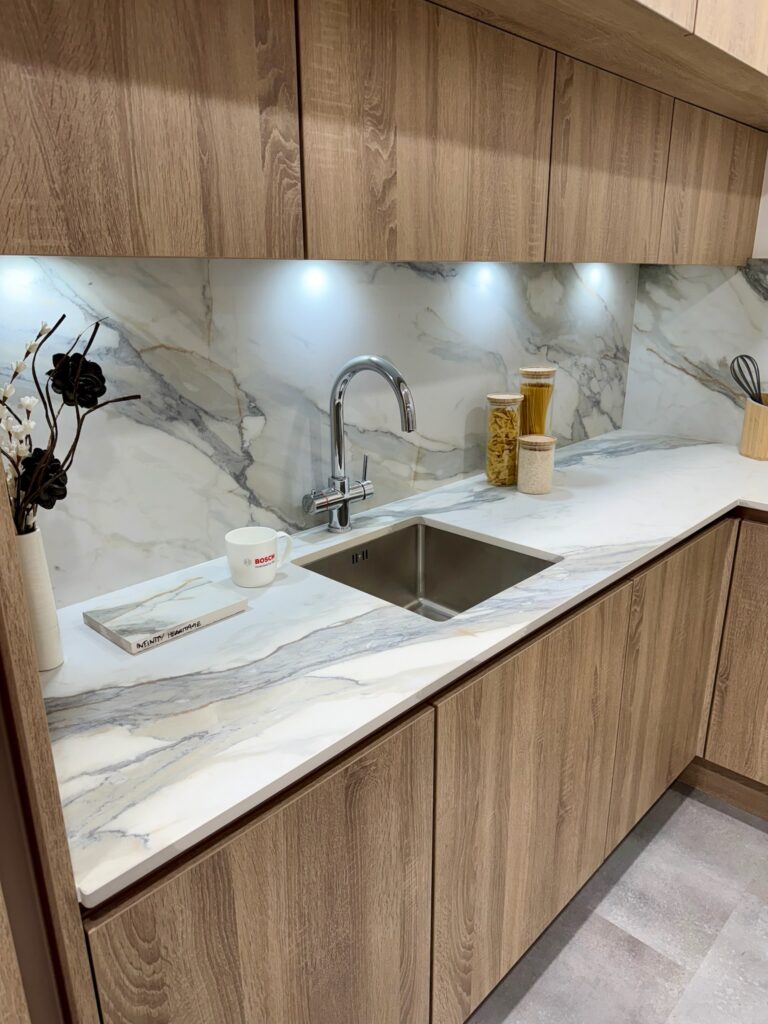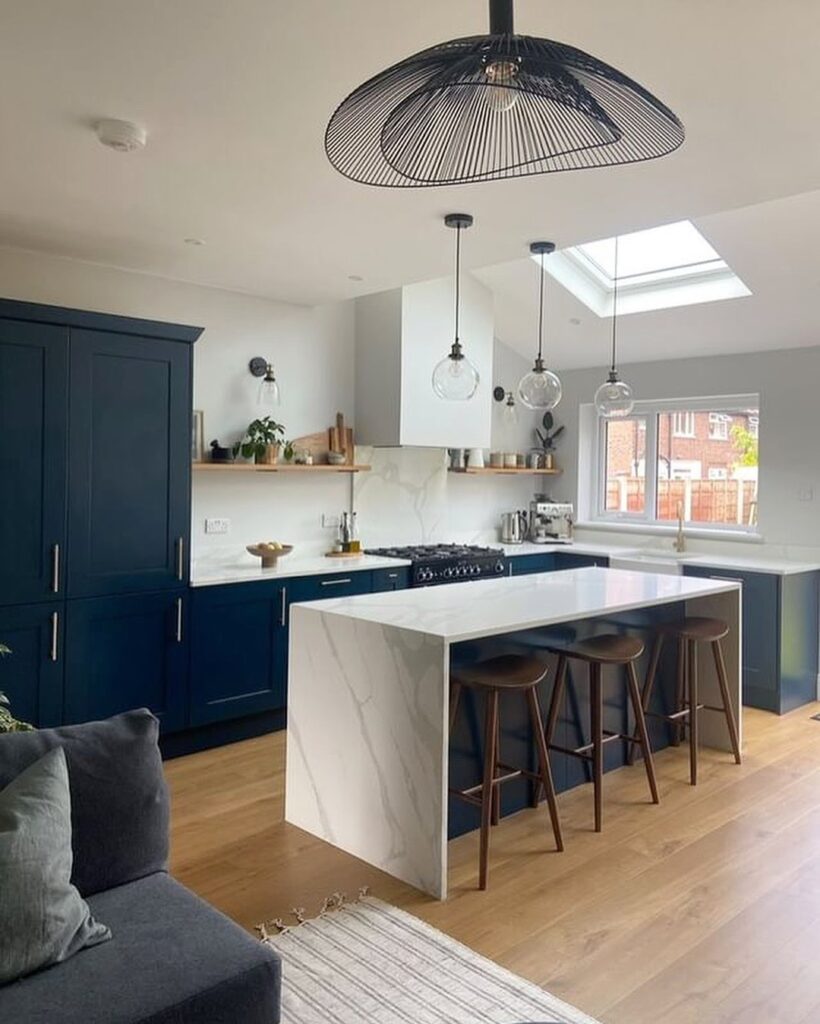Kitchens are now more than just a place to cook, they’re the heart of the home and a space where design meets daily life needs. Achieving a seamless kitchen design means creating a harmonious balance between all the key elements: your worktops, cabinets, flooring and appliances.
When each component complements the next, the visual results are stunning. In this article, we explore how different worktop materials can form the foundation of a beautiful kitchen.

Why choosing the right worktop is the foundation of a seamless kitchen design
When designing a kitchen, the worktop is often one of the first and most significant choices you make. It doesn’t just provide a functional surface, it sets the tone for your entire space. A carefully selected worktop can bring the visuals together, elevating the look of your kitchen and even influencing your choice of cabinetry, flooring and appliances.
Quartz and porcelain are two of the most popular worktop materials due to their premium appearance, durability, and design versatility. Granite offers bold natural patterning and robust performance, whilst marble introduces elegance with a timeless finish. Whether you’re creating a bold, modern aesthetic or a softer, understated theme, both of these surfaces can help you achieve a seamless kitchen design with beauty and practicality.

How to pair your worktop with cabinets for a balanced, stylish look
Cabinetry and worktops are two of the most dominant visual elements in any kitchen, so pairing them well is essential for a great result. Start by deciding whether you want contrast or coordination. For example, a light quartz worktop with fine veining pairs great with deep-toned cabinets such as navy, forest green or matt black, which gives off a dramatic but balanced effect.
If you prefer a softer, seamless look, maybe consider tone-on-tone pairing. A warm grey porcelain worktop can complement soft taupe or dove grey units for a calmer aesthetic. Natural granite worktops with rich, earthy tones work perfectly with wooden cabinetry, whilst marble appears better with classic shaker styles in muted shades.
Texture also plays a key role. High-gloss cabinets contrast strikingly with a matte porcelain surface and a more natural finish pairs best with painted or wooden doors. Overall, your choice of worktop should work together with your cabinetry, creating a visual flow.
Matching your worktop and flooring for a balanced kitchen aesthetic
Flooring and worktops are both foundational surfaces, so they don’t visually compete. Instead, aim for materials and tones that complement one another. For example, a white or marble-effect quartz worktop can be beautifully grounded by warm oak flooring, bringing natural texture into the space while keeping the palette balanced.
Porcelain worktops, particularly those with subtle concrete or stone finishes, work well with large-format floor tiles in coordinating colours. Choosing similar tones between surfaces can make the space feel bigger and enhance that ‘seamless’ look. You can also introduce patterns and contrast carefully, as long as the overall colour remains unified.
Granite and marble, being natural stones, often contain organic patterns and colours, so pairing them with more neutral flooring helps maintain harmony without visual clutter. By starting with your chosen worktop, you can select flooring that enhances and supports the visual impact of your surfaces, ensuring each element flows naturally into the next.
Coordinating worktops and appliances seamlessly
While appliances are often chosen for their function, their finish can significantly influence your kitchen’s overall look. Pairing your appliances with your worktop isn’t about matching perfectly, it’s about ensuring they don’t visually clash.
Stainless steel ovens, hobs and extractors tend to work well with quartz, porcelain, granite and marble, especially in cool-toned finishes. Black appliances offer a striking, modern contrast to lighter worktops and tie in seamlessly with darker designs. For a truly minimalist look, integrated appliances hidden behind cabinetry can allow your worktop to be centre stage.
When selecting appliances, think about how their lines and finishes interact with your surfaces. A handleless hob set into a pale quartz surface, for example, delivers a crisp, contemporary effect that feels effortless and refined.
Designing a unified kitchen from the worktop out
To achieve a seamless kitchen design, it helps to treat the worktop as your anchor point. Begin by selecting a surface that reflects your vision, whether that’s a clean, bright quartz for a minimalist space, a textured porcelain for something more industrial, a rich granite for bold character, or a soft marble for timeless charm.
From there, build a palette of complementary finishes and tones for your cabinetry, flooring and appliances. Collect samples, create a mood board, and look at your choices together in natural light. This design-led approach ensures that each element is considered in context, rather than chosen in isolation.
It’s also worth thinking practically, consider your lifestyle. If you need a surface that resists stains and heat, Quartz offers low maintenance and long-lasting beauty, while porcelain excels in durability and offers more flexibility in format and thickness. Granite is highly resistant to heat and scratches, while marble, though slightly more delicate, adds elegance.
Begin your seamless kitchen design journey
Creating a seamless kitchen design isn’t about making everything match, it’s about creating balance and flow. By choosing your worktop wisely and pairing it thoughtfully with cabinetry, flooring and appliances, you can design a kitchen that feels both luxurious and liveable.
Explore our collection of premium quartz, porcelain, granite and marble worktops to find the perfect starting point for your space. Whether you’re planning a full renovation or a simple refresh, contact us and we can help bring your design vision to life.
